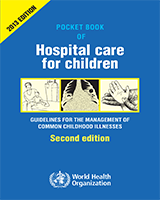All rights reserved. Publications of the World Health Organization are available on the WHO web site (www.who.int) or can be purchased from WHO Press, World Health Organization, 20 Avenue Appia, 1211 Geneva 27, Switzerland (tel.: +41 22 791 3264; fax: +41 22 791 4857; e-mail: tni.ohw@sredrokoob). Requests for permission to reproduce or translate WHO publications – whether for sale or for non-commercial distribution – should be addressed to WHO Press through the WHO web site (www.who.int/about/licensing/copyright_form/en/index.html).
NCBI Bookshelf. A service of the National Library of Medicine, National Institutes of Health.
Pocket Book of Hospital Care for Children: Guidelines for the Management of Common Childhood Illnesses. 2nd edition. Geneva: World Health Organization; 2013.

Pocket Book of Hospital Care for Children: Guidelines for the Management of Common Childhood Illnesses. 2nd edition.
Show detailsThe following table gives the composition of IV fluids that are commercially available and commonly used for neonates, infants and children. For a decision on which fluid to use in particular circumstances, see the disease-specific chapters, e.g. for shock (Chart 8), for neonates (section 3.10.2), for severely malnourished children (section 7.4.3), for surgical procedures (section 9.1.3) and for general supportive therapy (section 10.2). Please note that none of the fluids contains sufficient calories for the long-term nutritional support of children, but that some fluids contain less than others. When feed and fluids can be given by mouth or nasogastric tube, this is the safest, preferable route.
| IV fluid | Composition | ||||||
|---|---|---|---|---|---|---|---|
| Na+ | K+ | Cl− | Ca++ | Lactate | Glucose | Calories | |
| mmol/l | mmol/l | mmol/l | mmol/l | mmol/l | g/l | cal/l | |
| Ringer's lactate (Hartmann's) | 130 | 5.4 | 112 | 1.8 | 27 | – | – |
| Normal saline (0.9% NaCl) | 154 | – | 154 | – | – | – | – |
| 10% glucose | – | – | – | – | – | 100 | 400 |
| 0.45 NaCl/5% glucose | 77 | – | 77 | – | – | 50 | 200 |
| Darrow's solution | 121 | 35 | 103 | – | 53 | – | – |
| Half-strength Darrow with 5% glucosea | 61 | 17 | 52 | – | 27 | 50 | 200 |
| Half-strength Ringer's lactate with 5% glucose | 65 | 2.7 | 56 | 1 | 14 | 50 | 200 |
| 0.18% NaCl/4% glucoseb | 31 | – | 31 | – | – | 40 | 160 |
| 5% glucoseb | – | – | – | – | – | 50 | 200 |
- a
Half-strength Darrow's solution often comes without glucose, and glucose must be added before use.
- b
These fluids can be used mainly in the first few days of life but not in other infants or children.
A4.1. Choice of intravenous fluids
The risk for hyponatraemia may be increased with use of solutions containing very low sodium in paediatric patients, in comparison with fluids with a sodium content of 75–150 mmol/litre. Solutions containing low sodium, such as 0.18% sodium chloride with 4% glucose, or 5% glucose in water, should not be used for rehydration or fluid maintenance. Appropriate sodium-containing IV maintenance fluids should contain glucose to avoid hypoglycaemia and starvation ketosis in children who are unable to feed orally or by nasogastric tube.
- ►
Resuscitation: Children who are severely dehydrated or with signs of shock should be resuscitated with isotonic IV solutions (normal saline 0.9% or Ringer's lactate).
- ►
Intravenous maintenance fluid: Children who require IV fluids for maintenance should be managed with Ringer's lactate solution with 5% dextrose or 0.9% normal saline with 5% glucose or half-normal saline (0.45% sodium chloride) with 5% glucose.
- Intravenous fluids - Pocket Book of Hospital Care for ChildrenIntravenous fluids - Pocket Book of Hospital Care for Children
- Concise Conserved Domain Links for Protein (Select 1907155876) (0)Conserved Domains
Your browsing activity is empty.
Activity recording is turned off.
See more...